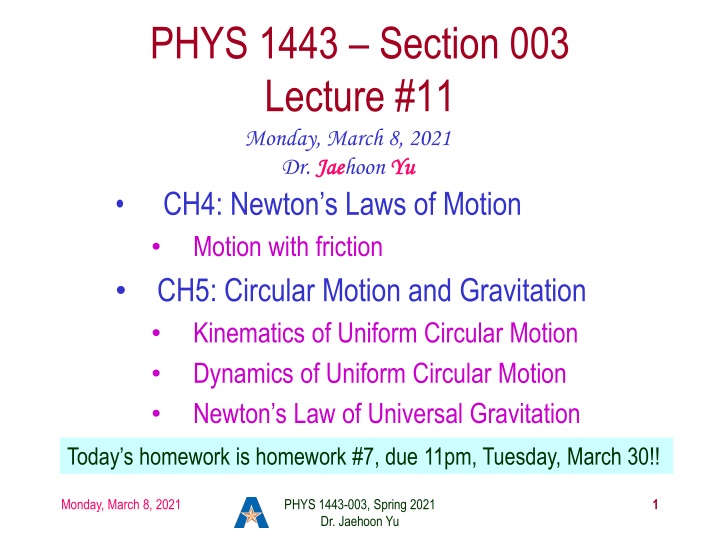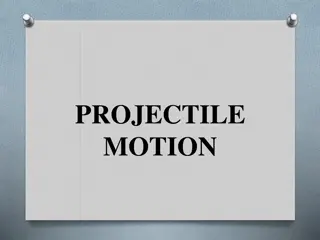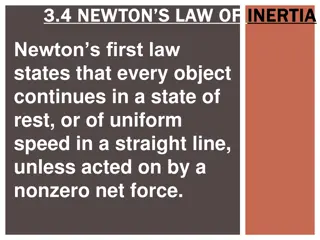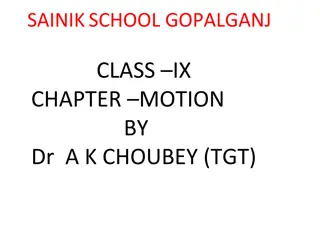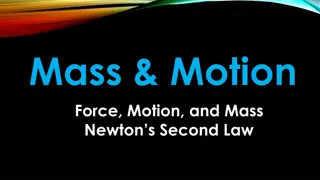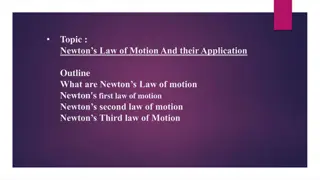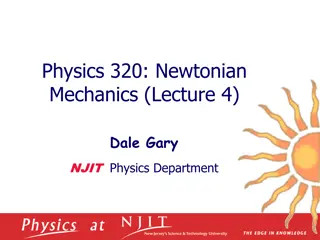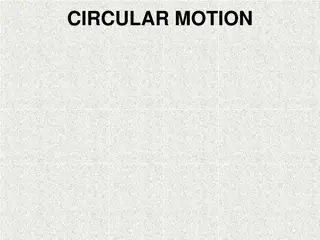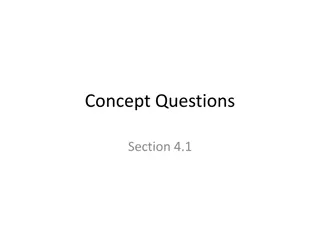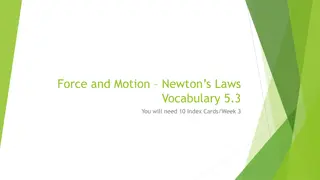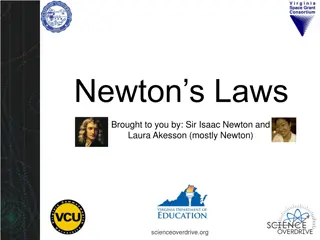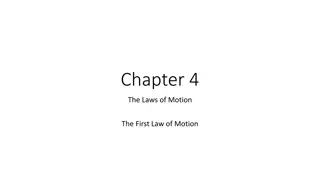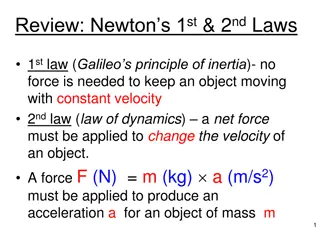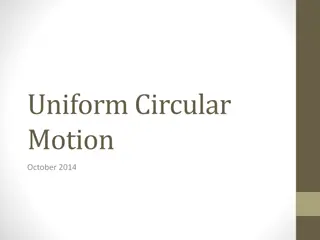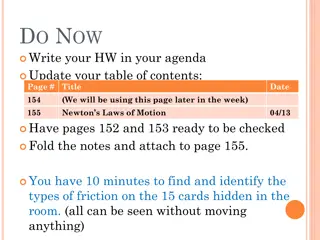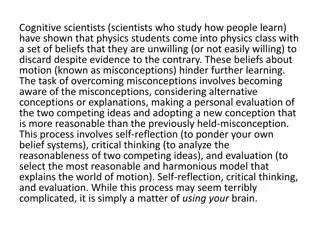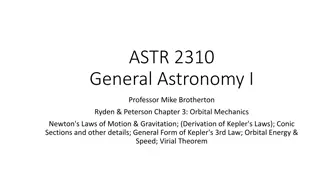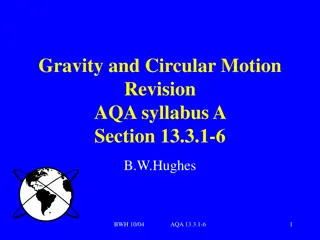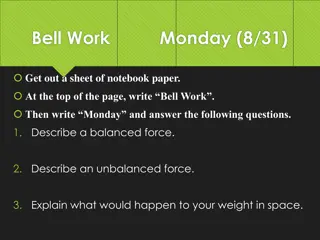PHYS 1443 Section 003 Lecture: Newton's Laws and Circular Motion Homework
Dive into the world of physics with Dr. Jae Jaehoon Yu as he covers Newton's Laws of Motion, motion with friction, circular motion, and gravitation. Stay on track with homework #7 due on March 30, and prepare for the mid-term exam. Explore kinematics and dynamics of uniform circular motion, Newton's law of universal gravitation, and more. Engage in statistical analysis of COVID-19 data and sharpen your quantitative skills. Don't miss out on announcements and extra credit opportunities!
Uploaded on Feb 25, 2025 | 1 Views
Download Presentation

Please find below an Image/Link to download the presentation.
The content on the website is provided AS IS for your information and personal use only. It may not be sold, licensed, or shared on other websites without obtaining consent from the author.If you encounter any issues during the download, it is possible that the publisher has removed the file from their server.
You are allowed to download the files provided on this website for personal or commercial use, subject to the condition that they are used lawfully. All files are the property of their respective owners.
The content on the website is provided AS IS for your information and personal use only. It may not be sold, licensed, or shared on other websites without obtaining consent from the author.
E N D
Presentation Transcript
PHYS 1443 Section 003 Lecture #11 Monday, March 8, 2021 Dr. Jae Jaehoon Yu CH4: Newton s Laws of Motion Motion with friction CH5: Circular Motion and Gravitation Kinematics of Uniform Circular Motion Dynamics of Uniform Circular Motion Newton s Law of Universal Gravitation Yu Today s homework is homework #7, due 11pm, Tuesday, March 30!! Monday, March 8, 2021 PHYS 1443-003, Spring 2021 Dr. Jaehoon Yu 1
Announcements Reading Assignments: CH5.4, 5.5 and 5.9 Mid-term comprehensive in class next Wednesday, March 10 Roll call begins at 2:20pm. Covers CH1.1 what we learn today, Monday, March 8 (CH5.5?)+ Math refresher Please do not miss the exam! You will get an F!! BYOF: You may bring one 8.5x11.5 sheet (front and back) of handwritten formulae and values of constants for the test No derivations, word definitions, setups or solutions of any problems, figures, pictures, diagrams or arrows, etc! Must email me the photos of front and back of the formula sheet, including the blank at jaehoonyu@uta.edu no later than 12:00pm the day of the test The subject of the email should be the same as your file name File name must be FS-E2-LastName-FirstName-SP21.pdf Once submitted, you cannot change, unless I ask you to delete part of the sheet! Quiz results: Class average 30/70 43/100 (Q1: 62/100) Top: 70/70 Reminder: Extra credit special COVID seminar at 4pm Saturday, March 20 Extra credit for participation and for asking the relevant questions Monday, March 8, 2021 PHYS 1443-003, Spring 2021 Dr. Jaehoon Yu 2
Reminder: SP #3 Statistical Analysis : COVID19 Make comparisons of COVID-19 statistics between the U.S., South Korea, Italy and Texas from https://coronaboard.com on spreadsheet Total 44 points: 1 point for each of the top 20 cells and 2 points for each of the 8 cells for vaccination Fill the US Historic event analysis table at the bottom 12 cells of the sheet (2 points per cell, 24 points total) and make a >3 sentence statement on COVID19 with respect to other events (6 points) What are the 3 fundamental quantitative requirements for opening up (2 points each, 6 points total)? Must be quantitative! (e.g. number of tests per capita per day, positivity rate, etc) Assess the readiness of the three fundamental requirements U.S. (Do NOT just take politician s words!). Must provide the independent scientific entity s reference you took the information from. (2 point each, total 6 points) Evaluate quantitatively the success/failure of the US responses to COVID-19 in 2020 in 5 sentences and that in 2021 in 5 sentences. Must provide quantitative reasons behind your conclusion! (2 points each sentence, 20 points total) Assess quantitatively the effectiveness of wearing masks (4 points) and at least 4 reasons for it being effective (1 point each, 0.5 point extra after the first 4). Possible maximum: 122 points total Due: 11pm, Friday, March 19 Submit one pdf file SP3-YourLastName-YourFirstName.pdf, including the spreadsheet Spreadsheet will be posted on canvas. Download ASAP. Monday, March 8, 2021 PHYS 1443-003, Spring 2021 Dr. Jaehoon Yu 3
PHYS1443-003, Spring 21, Special Project #3, Statistical Analysis - COVID19 Date? &? time? of? your? COVID-19? Data:? South?Korea Name: Items U.S.A Italy Texas Total? Population Total COVID-19? Confirmed? cases Cases per 1M people Total COVID-19? Deaths Death per 1M people Total COVID-19? Testing Testing per 1M people Poditivity Rate Total COVID-19 Vaccination to date Per 1M people US?Vietnam?War US?World?War?II COVID-19 US H1N1 Time? period? (mm/dd/yy? -? MM/DD/YY) Duration? in? Months US Historic Event Analysis Total? deaths Death? per? month Monday, March 8, 2021 PHYS 1443-003, Spring 2021 Dr. Jaehoon Yu 4
Steps for solving mechanics problems using Newton s Laws 1. Identify all the forces acting on the object of interest in the problem. 2. Establish a vector sum equation using all identified forces. Note that the vector sum of all forces are the net force that provides the acceleration to the object s motion 3. Set the coordinates so that one axis aligns with the anticipated direction of motion (=direction of the net force!). 4. Identify all components of the forces in each coordinate. 5. Establish the force equation for each component, whose right hand- side is the mass of the object times the acceleration in that particular direction. 6. Solve each equation of component for the the quantities of interests. 7. If any further equation of motion is of interest, use combinations of kinematic equations to obtain the answers. Monday, March 8, 2021 PHYS 1443-003, Spring 2021 Dr. Jaehoon Yu 5
Example w/ Friction Suppose a block is placed on a rough surface inclined relative to the horizontal. The inclination angle is increased till the block starts to move. Show that by measuring this critical angle, c, one can determine coefficient of static friction, s. +y f fs s= = sn n n n n Free-body Diagram f fs s= = sn +x F Fg g F Fg g= = - -Mg g Net force eq. Fgx- fs= Mgsinq - fs=0 fs= msn = = sin Mg x F x comp. c = = = = = = 0 cos n Mg n cos y F Ma n F F Mg y comp. c y gy gy c sin Mg c sin Mg c = ms= tan c = cos Mg n c Monday, March 8, 2021 PHYS 1443-003, Spring 2021 Dr. Jaehoon Yu 6
Motion in Resistive Force A medium can exert resistive forces on an object moving through it due to viscosity or other types frictional properties of the medium. Some examples? Air resistance, viscous force of liquid, etc These forces are exerted on moving objects in the opposite direction to the movement. These forces are proportional to such factors as speed. They almost always increase with increasing speed. Two different cases of proportionality: 1. Forces linearly proportional to speed: Slowly moving or very small objects 2. Forces proportional to square of speed: Large objects w/ reasonable speed Monday, March 8, 2021 PHYS 1443-003, Spring 2021 Dr. Jaehoon Yu 7
Definition of the Uniform Circular Motion Uniform circular motion is the motion of an object traveling at a constant speed on a circular path. Monday, March 8, 2021 PHYS 1443-003, Spring 2021 Dr. Jaehoon Yu 8
Speed of a uniform circular motion? Let T be the period of this motion, the time it takes for the object to travel once around the complete circle whose radius is r is distance time v = r = 2p r T Monday, March 8, 2021 PHYS 1443-003, Spring 2021 Dr. Jaehoon Yu 9
Ex. : A Tire-Balancing Machine The wheel of a car has a radius of 0.29m and is being rotated at 830 revolutions per minute on a tire-balancing machine. Determine the speed at which the outer edge of the wheel is moving. 1 830revolutions min= 1.2 10-3min revolution T = 1.2 10-3 min = 0.072 s ( 0.072 s ) 2pr T 2p 0.29 m v = = = 25m s Monday, March 8, 2021 PHYS 1443-003, Spring 2021 Dr. Jaehoon Yu 10
Centripetal Acceleration In a uniform circular motion, the speed is constant, but the direction of the velocity vector is not constant. + = 90 + =90 = 0 = The change of direction of the velocity is the same as the change of the angle in the circular motion! Monday, March 8, 2021 PHYS 1443-003, Spring 2021 Dr. Jaehoon Yu 11
Centripetal Acceleration Dv 2 v vDt 2 r = sin q 2 ( )= From geometry 2 v v t = r 2 v ca = r What is the direction of ac? Always toward the center of the circle! Centripetal Acceleration Monday, March 8, 2021 PHYS 1443-003, Spring 2021 Dr. Jaehoon Yu 12
Newtons Second Law & Uniform Circular Motion The centripetal * centripetal * acceleration is always perpendicular velocity vector, v v, and points to the center of the axis direction) in a uniform circular motion. perpendicular to the center of the axis (radial 2 r a = v r Are there forces in this motion? If so, what do they do? The force that causes the centripetal acceleration acts toward the center of the circular path and causes the change in the direction of the velocity vector. This force is called the centripetal force. What do you think will happen to the ball if the string that holds the ball breaks? The external force no longer exist. Therefore, based on Newton s 1st law, the ball will continue its motion without changing its velocity and will fly away along the tangential direction to the circle. *Mirriam Webster: Proceeding or acting in the direction toward the center or axis 2 v = = rF m ma r r Monday, March 8, 2021 PHYS 1443-003, Spring 2021 Dr. Jaehoon Yu 13
Ex. For Uniform Circular Motion A ball of mass 0.500kg is attached to the end of a 1.50m long cord. The ball is moving in a horizontal circle. If the string can withstand the maximum tension of 50.0 N, what is the maximum speed the ball can attain before the cord breaks? 2 v r a = Centripetal acceleration: r 2 v When does the string break? = = r F ma m T r r when the required centripetal force is greater than the sustainable tension. 2 v 50.0 1.5 0.500 Tr m= ( ) v = = = mr 12.2 / m s T ( ) 2 2 5.00 1.5 v Calculate the tension of the cord when speed of the ball is 5.00m/s. ( ) = T = = mr 0.500 8.33 N Monday, March 8, 2021 PHYS 1443-003, Spring 2021 Dr. Jaehoon Yu 14
Example: Banked Highway (a) For a car traveling with speed v around a curve of radius r, determine the formula for the angle at which the road should be banked so that no friction is required to keep the car from skidding. y 2 mv = = ma sin F x F = x comp. r N r 2 mv = sin F N r = yF = = x cos cos F mg F mg y comp. 0 N N v2 mg 2 sin mv mg = = = sin F tan = = F tan mg N N cos gr r cos (b) What is this angle for an expressway off-ramp curve of radius 50m at a design speed of 50km/h? ( ) 50 2 14 ( 4 . 0 ) = = 50 / 14 / v km hr m s = 4 . 0 = = = o 1 tan tan 22 8 . 9 Monday, March 8, 2021 PHYS 1443-003, Spring 2021 Dr. Jaehoon Yu 15
Forces in Non-uniform Circular Motion The object has both tangential and radial accelerations. What does this statement mean? The object is moving under both tangential and radial forces. F F F Fr r F Ft t These forces cause not only the velocity but also the speed of the ball to change. The object undergoes a curved motion in the absence of constraints, such as a string. a = + 2 r 2 t a a What is the magnitude of the net acceleration? Monday, March 8, 2021 PHYS 1443-003, Spring 2021 Dr. Jaehoon Yu 16
Ex. for Non-Uniform Circular Motion A ball of mass m is attached to the end of a cord of length R. The ball is moving in a vertical circle. Determine the tension of the cord at any instance in which the speed of the ball is v and the cord makes an angle with vertical. What are the forces involved in this motion? V m The gravitational force Fg The radial force, T, providing the tension. T T F Fg g= =mg g R = at= sin mg = sin ma g tF tangential comp. t 2 v 2 v Radial comp. + = = = = cos cos T mg T m g rF ma m r R R At what angles the tension becomes the maximum and the minimum. What are the tensions? Monday, March 8, 2021 PHYS 1443-003, Spring 2021 Dr. Jaehoon Yu 17
